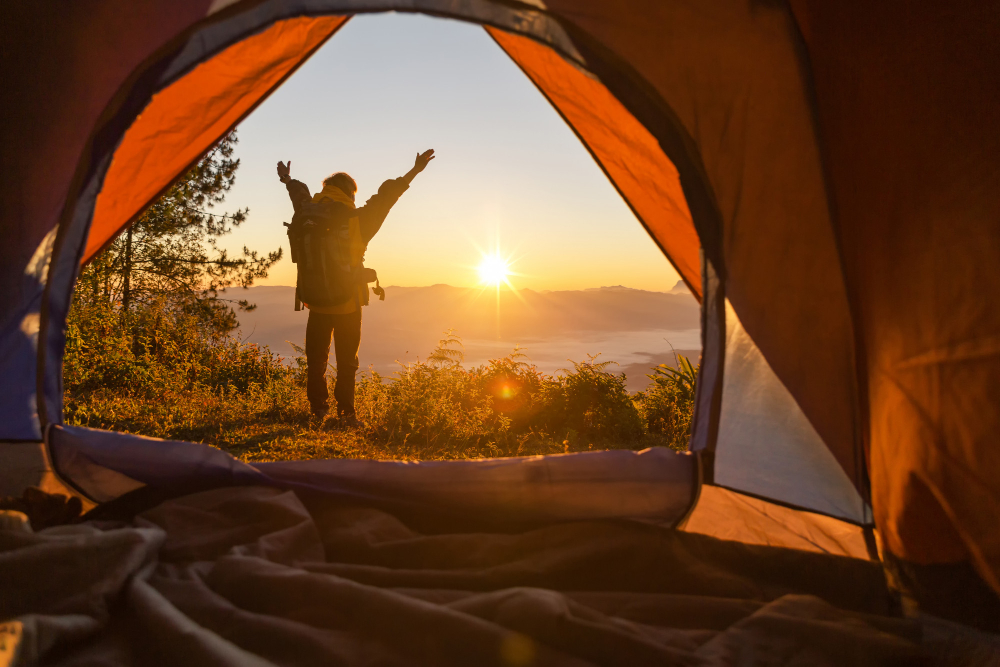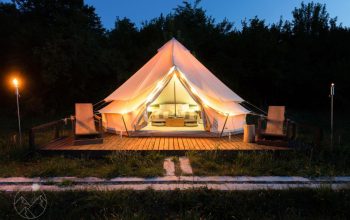When planning a camping trip, one of the first things you need to do is choose the right dome tent.
There are many factors to consider, such as the size of the tent, the features you need, and your budget. To help you make the best choice, we’ve put together a few tips on choosing the perfect dome tent for your next camping trip.

How To Choose The Perfect Dome Tent
First, consider the size of the tent. It should be large enough to sleep the number of people camping with you comfortably. Second, think about the features you need. Some tents have built-in storage pockets, while others have awnings for shade. Third, consider your budget.
There are a variety of tents available at different price points. With these tips in mind, you can find the perfect tent for your next camping trip.
1. Decide how many people will be using the tent.
Now that you’ve decided to go camping, it’s time to choose the perfect dome tent for your trip! This is an important decision, as the wrong tent can ruin your experience. Here are a few things to consider when choosing a tent:
- Decide how many people will be using the tent. This is the most critical factor in determining a tent. It would be best to ensure the tent is big enough to fit everyone using it comfortably. Otherwise, you’ll be spending your whole trip cramped up and unhappy.
- Consider the climate you’ll be camping in. You’ll want a tent with good ventilation if you plan to camp in a hot climate. On the other hand, if you’re camping in a cold climate, you’ll want a well-insulated tent.
- Think about the features you want. Some tents have features like a built-in rainfly or a detachable screen room. These can be nice to have, but they’re not essential. Decide which features are most important to you and choose a tent accordingly.
- Compare prices. Tents can range in price from very affordable to very expensive. It’s essential to find a tent that’s within your budget. However, don’t sacrifice quality for the price. A cheap tent will not last as long or be as comfortable as a more expensive one.
- Read reviews. Once you’ve narrowed your choices, it’s a good idea to read online reviews of the tents you’re considering. Hearing about other people’s experiences with a particular tent can help you make your final decision. Following these simple tips, you can choose the perfect dome tent for your next camping trip!
2. Consider what time of year you will be camping.
When choosing a dome tent, one of the critical things to consider is what time of year you will be camping. After all, different tents are better suited for different seasons. If you’re only camping in the summer, you won’t need a tent designed for icy weather conditions. However, if you plan camping in the spring or autumn, you’ll need a tent that can withstand cooler temperatures. Three main types of tents are three-season, four-season, and winter.
Three-season tents are the most popular type of tent, as they can be used for camping in the spring, summer,r and autumn. They usually have mesh panels to allow for ventilation in warm weather and are made from waterproof and breathable fabric to keep you dry in the rain. Four-season tents are designed for all weather conditions and have a solid inner canopy to keep you warm in the winter. Winter tents are the heaviest and most durable type of tent explicitly designed for cold weather conditions.
They have a thick outer shell to protect against the wind and snow and a waterproof and insulated inner layer to keep you warm and dry. When choosing a dome tent, it’s essential to consider what time of year you’ll be using it. If you only camp in the summer, a three-season tent will suffice. However, you’ll need a four-season tent if you plan to go camping in the spring or autumn.
And if you’re planning on winter camping, you’ll need a winter tent. Choose the wrong type of tent, and you’ll be miserable on your camping trip. So make sure to take the time to consider what time of year you’ll be using your tent before making your purchase.
3. Choose a size and style of dome tent that will fit your needs.
When choosing a dome tent for your next camping trip, there are a few things to consider. First and foremost, you must decide how many people will be camping with you. You can get away with a smaller ten if it’s just you and a buddy.
But if you’re bringing the whole family, you’ll need a giant tent. Secondly, you must decide what kind of camping you’ll do. If you’re car camping, you can get away with a bigger and heavier tent. But if you’re backpacking, you’ll need to choose a lighter tent. Lastly, deciding what weather you’ll be camping in would be best. If you’re camping in warm weather, your tent won’t need as much insulation.
But if you’re camping in cold weather, you’ll need a warmer tent. Once you’ve considered these factors, you can start narrowing down your choices. There are a few different styles of dome tents to choose from. The most popular type is the three-season tent. These tents are great for camping in spring, summer, and fall. They’re not as well insulated as four-season tents, so they’re not ideal for winter camping. If you’re looking for a light tent for backpacking, you might want to choose a two-person tent.
These tents are small and easy to carry. But, they might not be big enough for your whole family when selecting a dome tent; it’s essential to pick a size and style that will fit your needs. With so many different options on the market, it’s easy to find a tent perfect for your next camping trip.
4. Read reviews of tents to help you make your decision.
Reading reviews can be beneficial when choosing the perfect dome tent for your next camping trip. Remember four things when reading reviews to help you make your decision:
- Pay attention to the details. What do reviewers like or dislike about the tent? Are there any specific features that stand out? How easy is the tent to set up and take down?
- Consider the reviewer’s needs. What type of camping are they doing? Are they looking for a lightweight tent for backpacking or a sturdier option for car camping? Do they have specific requirements, such as needing a tent with a built-in rainfly?
- Take note of any negatives. What do reviewers say are the downsides of the tent? Are there any durability concerns? Are there any known issues with the tent, such as leaks?
- Compare similar tents. How does the tent you’re considering stack up against other options? What are the pros and cons of each?
- By reading reviews, you’ll get a better sense of which tent is the right fit for you and your camping needs.
5. Determine your budget for the tent.
The great thing about dome tents is that there is a wide range of prices. For a top-of-the-line model, you can find a cheap dome tent for under $10 or over $500. So, how do you know how much to spend on a dome tent? Here are a few things to keep in mind as you set your budget for a new tent:
- The price of a tent does not necessarily reflect its quality. Just because a tent is expensive does not mean it will be better than a cheaper model. The same goes for more affordable tents – they can often be just as good as their more expensive counterparts.
- The type of camping you plan to do will affect how much you need to spend on a tent. If you only camp occasionally and in fair weather, you probably don’t need to spend much on a tent. Conversely, if you often camp in rough conditions, you’ll need a sturdier, more expensive tent.
- The size of your camping group will also affect your budget. If you usually camp alone or with another person, you won’t need a big tent. However, if you often camp with a large group, you’ll need to spend more on a giant tent.
- Finally, consider the features you want in a tent. Some features, such as a built-in rainfly, will add to the cost of the tent. But, if you often camp in wet conditions, a rainfly is an essential feature worth the extra cost. Keep these considerations in mind as you set your budget for a new dome tent, and you’ll be sure to find the perfect one for your needs.

6. Compare prices and features of different tents.
Tent camping is a great way to enjoy the outdoors without having to spend a lot of money. However, before camping, you must choose the right tent. Otherwise, you may end up being cold, wet, and uncomfortable.
There are a few things to consider when choosing a tent, such as the size, weight, price, and features. Size The first thing to consider is the size of the tent. How many people will be sleeping in the tent? If you have a family of four, you’ll need a giant tent rather than camping with a friend.
Weight The next thing to consider is the weight of the tent. If you’re planning on hiking to your campsite, you’ll want a lighter tent.
However, weight isn’t as big of a concern if you’re driving to your camp. Of course, price is always a concern. Tent prices can range from $50 to $500. It all depends on the size and features of the tent. Features Some features to look for in a tent include a rain fly, a vestibule, and an integrated groundsheet.
A rain fly is a fabric that goes over the top of the tent to keep you dry if it rains. A vestibule is a covered area outside the tent where you can store your gear. An integrated groundsheet is a fabric that goes under the tent to keep you dry and comfortable.
Now that you know what to look for in a tent, it’s time to start shopping around. Compare prices and features of different tents to find the perfect one for your next camping trip.
7. Select the perfect dome tent for your next camping trip!
There is no perfect dome tent for everyone or every camping trip. The ideal tent for you will depend on various factors, including the type of camping you’ll be doing, the size and composition of your camping group, the amount of gear you’ll be bringing, the weather conditions you anticipate, and your personal preferences. To help you select the perfect dome tent for your next camping trip, here are seven things to consider:
- The type of camping you’ll be doing. Are you planning to backpack into the backcountry for a week-long trip? Or are you driving to a developed campsite where your car will be just a few steps from your tent? The type of camping you’ll be doing will impact the size, weight, and features of the tent you choose.
- The size and composition of your camping group How many people will be camping with you? Are you tall? Do you have small children or pets? All these factors will impact the tent size you need and the type of features most important to you.
- The amount of gear you’ll be bringing. Will you bring a lot of equipment or just the essentials? If you’re planning to get gear for fishing or kayaking, you’ll need a tent with more storage space.
- The weather conditions you anticipate Do you anticipate inclement weather on your trip? If so, you’ll want to choose a tent that can withstand high winds and heavy precipitation.
- Your personal preferences Do you prefer a tent with a lot of headroom? Do you like the feeling of being surrounded by your sleeping space? Consider your personal preferences when selecting a dome tent.
- Tents can range in price from less than $100 to several thousand dollars. It’sessentialt to set a budget and choose a tent that fits that budget.
- The reviews Once you’ve narrowed your choices, look at online reviews of the tents you’re considering. This can be a helpful way to finalize your decision. What do other campers have to say about the tents?
Now that you know the different features to look for in a dome tent, you can start shopping for the perfect one for your next camping trip.
Be sure to read the reviews of any tent you’re considering before purchasing it to ensure it meets your needs. You can find the perfect tent for your next adventure with some research.





